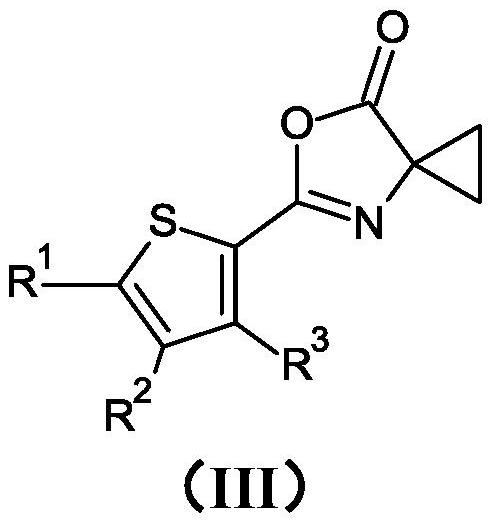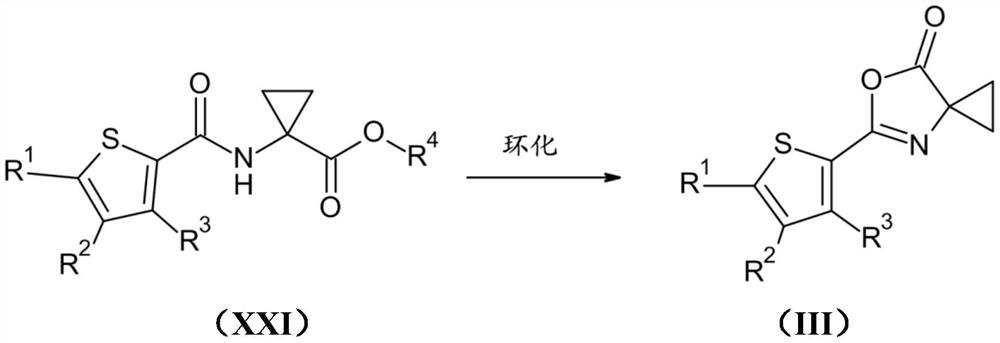Substituted thiophenecarboxamides and analogues as antibacterials agents
A methyl and plant-based technology, which is applied to compounds, biocides, and disinfectants of elements of group 4/14 of the periodic table, and can solve problems such as poor effects
- Summary
- Abstract
- Description
- Claims
- Application Information
AI Technical Summary
Problems solved by technology
Method used
Image
Examples
preparation Embodiment 1
[0333] Preparation Example 1 : Preparation of 5-(4,5-dibromo-3-fluoro-2-thienyl)-6-oxa-4-azaspiro[2.4]hept-4-en-7-one (Compound III.01)
[0334] step 1 : Preparation of ethyl 1-{[(4,5-dibromo-3-fluoro-2-thienyl)carbonyl]amino}cyclopropanecarboxylate (Compound XXI.01)
[0335] To 200 mg (0.66 mmol) of 4,5-dibromo-3-fluorothiophene-2-carboxylic acid and 170 mg (1.32 mmol) of ethyl 1-aminocyclopropanecarboxylate hydrochloride (1:1) were dissolved in 3 mL of tetrahydrofuran To the solution was added 0.14 mL (1.00 mmol) of triethylamine followed by 0.59 mL (1.00 mmol) of a 50% (w / w) solution of propanephosphonic anhydride in ethyl acetate. The reaction mixture was stirred at room temperature for 2 hours. The reaction mixture was quenched with water and extracted with ethyl acetate. The combined organic layers were dried over magnesium sulfate, filtered and concentrated under reduced pressure. The residue was purified by silica gel column chromatography (gradient n-heptane / et...
preparation Embodiment 2
[0340] Preparation Example 2 : Preparation of intermediate ethyl 1-{[(4,5-dichloro-3-methyl-2-thienyl)carbonyl]amino}cyclopropanecarboxylate (Compound XXI.11)
[0341] Under an inert atmosphere, 100 mg (0.23 mmol) of ethyl 1-{[(4,5-dichloro-3-iodo-2-thienyl)carbonyl]amino}cyclopropanecarboxylate (compound XXI.08), 21 mg (0.34 mmol) of methylboronic acid, 2.6 mg (0.01 mmol) of palladium(II) acetate, 6.5 mg (0.02 mmol) of tricyclohexylphosphine and 172 mg (0.80 mmol) of tripotassium phosphate, Degassed toluene (1.25 mL) and water (0.13 mL) were then added. The vial was sealed and the reaction mixture was stirred at 100°C for 18 hours. The reaction mixture was diluted with water and extracted with dichloromethane. The combined organic layers were passed through Chem Elut TM The cartridge was filtered and concentrated under reduced pressure. The residue was purified by silica gel column chromatography (gradient n-heptane / ethyl acetate) to give 29 mg (purity 100%, yield 39%) ...
preparation Embodiment 3
[0342] Preparation Example 3 : Preparation of intermediate ethyl 1-{[(3,4,5-trichloro-2-thienyl)carbonyl]amino}cyclopropanecarboxylate (Compound XXI.05)
[0343] step 1 : Preparation of ethyl 1-{[(3-amino-4,5-dichloro-2-thienyl)carbonyl]amino}cyclopropanecarboxylate (Compound XXVIII.01)
[0344] To 150 mg (0.60 mmol) of 3-amino-4,5-dichlorothiophene-2-carboxylate hydrochloride (1:1) (compound XXXa.02) and 255 mg (1.50 mmol) of 1-aminocyclopropanecarboxylic acid To a solution of ethyl ester hydrochloride (1:1) dissolved in 4.0 mL of dichloromethane was added 0.45 mL (2.59 mmol) of N,N-diisopropylethylamine, followed by 255 mg (1.50 mmol) of 2- A solution of chloro-1,3-dimethylimidazolium chloride in 2.0 mL of dichloromethane. The reaction mixture was stirred at room temperature for 16 hours. The reaction mixture was quenched with water and extracted with dichloromethane. The combined organic layers were dried over magnesium sulfate, filtered and concentrated under reduce...
PUM
 Login to View More
Login to View More Abstract
Description
Claims
Application Information
 Login to View More
Login to View More - Generate Ideas
- Intellectual Property
- Life Sciences
- Materials
- Tech Scout
- Unparalleled Data Quality
- Higher Quality Content
- 60% Fewer Hallucinations
Browse by: Latest US Patents, China's latest patents, Technical Efficacy Thesaurus, Application Domain, Technology Topic, Popular Technical Reports.
© 2025 PatSnap. All rights reserved.Legal|Privacy policy|Modern Slavery Act Transparency Statement|Sitemap|About US| Contact US: help@patsnap.com



